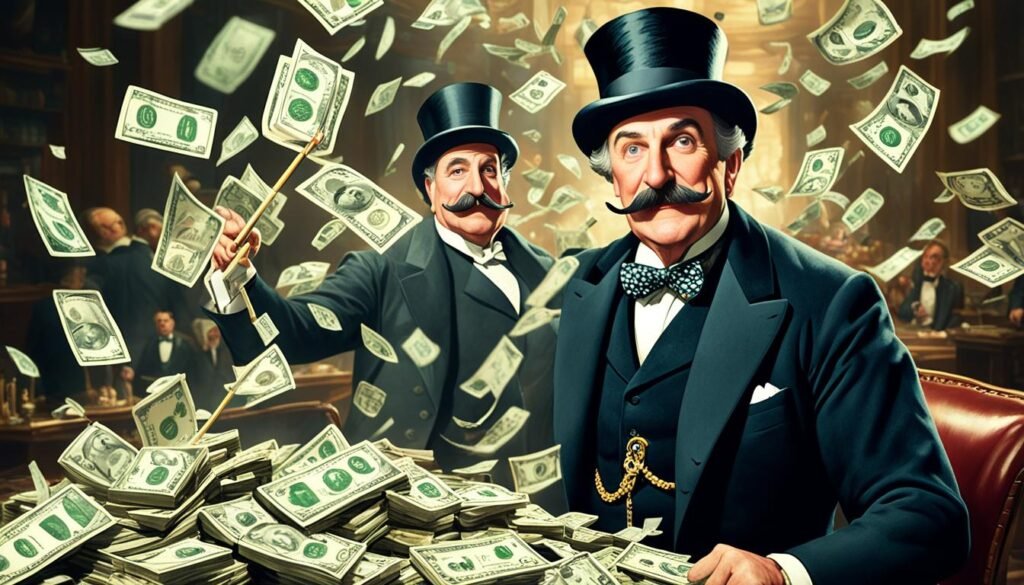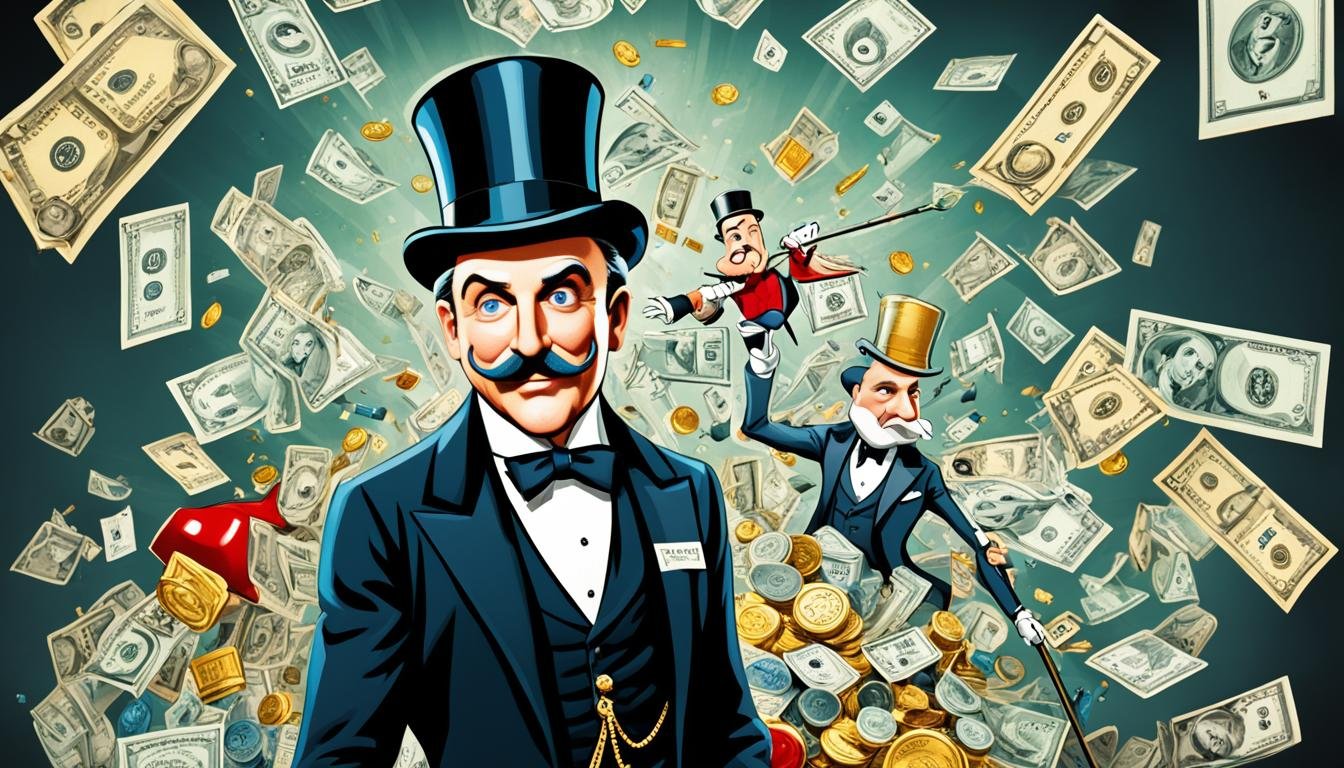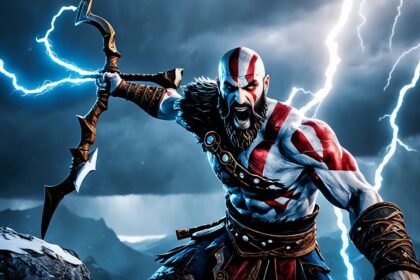Mr Monopoly, also known as Rich Uncle Pennybags, is the iconic game piece from Monopoly. This popular board game was created by Lizzy Magie in the early 1900s. It was first meant to show how land grabbing in the Gilded Age was greedy. The game’s idea changed when Charles Darrow became known as its sole creator.
The character of Mr Monopoly is shown as a rich man wearing a top hat and a suit. He symbolizes wealth and capitalism in the game.
Key Takeaways:
- Mr Monopoly, also known as Rich Uncle Pennybags, is the iconic game piece of Monopoly.
- Created by Lizzy Magie in the early 1900s, Monopoly was originally an anticapitalist game.
- The character of Mr Monopoly represents wealth and capitalism.
- Mr Monopoly is depicted as a portly man in a top hat and suit.
- Mr Monopoly has become the face of the Monopoly game.
The Origins of Monopoly Game Tokens
Monopoly game tokens are famous symbols in board games across the globe. They are small and noticeable parts of playing the game. When Monopoly started in the 1930s, there were different tokens like the top hat, thimble, iron, boot, battleship, cannon, and racecar.
The top hat is inspired by the character called Mr. Monopoly. He’s also known as Rich Uncle Pennybags. It’s one of the most well-known parts of the Monopoly game. Some of the original tokens are not used anymore in new editions of the game.
For example, in newer games, you won’t find the thimble, boot, and iron. Game makers removed these to bring in new tokens. They made these changes to keep the game fresh and fun for players.
In various versions of Monopoly, there are new tokens based on the game’s theme. In the Electronic Banking Edition, you can pick a Space Shuttle or a Segway. This makes the game more exciting and up to date with modern times.
Special editions like Monopoly Empire have tokens from famous brands. For example, you might find tokens from Coca-Cola and McDonald’s. In Monopoly for Millennials, there are emojis and hashtags as tokens. This shows how Monopoly adapts to new trends over time.
It’s interesting to watch how Monopoly game tokens have changed. They mirror our taste, current trends, and new technology. The tokens have turned into cherished items and are key to enjoying Monopoly games.
Today, these tokens are still important in Monopoly. They affect how players think and play to win the game.
| Token | Retired Year |
|---|---|
| Thimble | 2017 |
| Iron | 2017 |
| Boot | 2017 |
| Battleship | – |
| Cannon | – |
| Racecar | – |
| T-Rex | – |
| Rubber Ducky | – |
| Penguin | – |
The Evolution of Monopoly Tokens
Monopoly, the famous board game, has been around for many years. So have the game pieces, or tokens. Each token has a special meaning and its own place in our hearts. These items have changed a lot over time, showing how our culture and game preferences have evolved.
The game’s tokens are crucial in Monopoly. When you start, you choose a token to be your playing piece. It represents your journey in the game, as you compete to be the wealthiest and control the board. Everyone hopes to own prime locations like Boardwalk and Park Place.
The Early Tokens and Retirements
In the early years of Monopoly, tokens like the racecar and top hat were very popular. There was even a thimble that many players loved. But some tokens were eventually replaced with newer ones, like a cannon and a lantern, to keep the game fresh. Later, we saw tokens like a bathtub and a cannon on wheels, reflecting their times.
Over time, several other tokens, including a purse and a rocking horse, were also removed. This move made space for newer and more interesting tokens. These changes have always kept the game exciting and up to date with what players enjoy.
Themed Tokens and Unique Editions
Monopoly eventually started offering special versions with themes. This lets players enjoy the game with tokens from their favorite stories or series. Games like The Nightmare Before Christmas and Australia Post have unique tokens that fit their themes perfectly.
In recent times, Monopoly introduced tokens from different lifestyles, like a space shuttle. These additions not only make the game play more fun. They also show how the game stays current with player interests.
Possible Future Tokens
“Monopoly tokens are always changing to stay fun and relevant. As time goes on, we might see new tokens that reflect our world today. Imagine playing with a penguin, a CRT television, or a modern racecar. There could even be an emoji of Mr. Monopoly. These new tokens would surely keep Monopoly a favorite game for many more years.”
Monopoly began as a simple game and is now known all over the world. Its tokens have also evolved, from the original favorites to new additions. These pieces are not just for playing; they symbolize the game’s strategy, wealth, and changing face over time. Monopoly tokens are much more than just game items. They are part of what makes the game special to us.
| Decades | Retired Tokens | New Tokens Introduced |
|---|---|---|
| 1930s | Lantern | Bathtub |
| 1950s | Cannon | Cannon with Wheels |
| Various Decades | Purse, Rocking Horse, Iron | Various Others |
| 2017 | T-Rex | – |
The Monopoly Man: Rich Uncle Pennybags
Rich Uncle Pennybags is the name of the Monopoly Man. He’s the face of the Monopoly board game. This plump character wears a top hat and a mustache. He stands for big money, business, and chasing after wealth.
He draws inspiration from a real American businessman. J.P. Morgan’s style is reflected in this Gilded Age symbol. He showcases the era’s opulence and the hunger for money that comes with capitalism. The Monopoly Man first stepped into U.S. editions in 1936. But, he wasn’t named until the Rich Uncle game in 1946.
“With his top hat, suit, and mustache, the Monopoly Man embodies the spirit of wealth and opportunity that the game Monopoly is all about.”
The Monopoly Man has become key to the game’s identity. Players often land on cards bearing his image. And from 1985 to 2008, his silhouette was in the Monopoly logo.
In 1999, his original name was replaced with Mr. Monopoly. This symbol of wealth now has quite a following. Actors like Tony Waldman and Tony Pope voiced him in media. He’s been fictionalized with a niece and two nephews, Sandy, Andy, and Randy respectively.
There’s an interesting story about Mr. Monopoly wearing a monocle. This memory mix-up is called the Mandela effect. he truth is, this character never wore one. The mix-up might have come from Mr. Peanut, who does wear a monocle.
Mr. Monopoly has also become a symbol for good in recent years. People dressed as him have made appearances at notable events. This highlights and pokes fun at wealth and capitalism in real life.
Mr. Monopoly’s fame has outgrown the Monopoly board. Since the 1930s, he’s appeared in many games and products. He is a lasting symbol of wealth and achievement.
His image is everywhere in Monopoly. He decorates cards and the speedy dice. With his unique style, including a memorable mustache, he’s unforgettable. Clearly, he’s made a permanent mark on popular culture.
The Monopoly Man and the Mandela Effect
Many people wrongly think the Monopoly Man wears a monocle. Even though the game and its versions never showed him with one, this idea sticks. Movies and TV might have played a part in making us think he has a monocle.
The mistake about the Monopoly Man shows how our memories can be wrong. We often remember things the way others do, showing the power of culture on memory. This is called the Mandela Effect, named after a situation with Nelson Mandela from the 1980s.
The Monopoly Man brings up interesting thoughts on memory. It makes us question how much culture can change our memory. This situation reminds us that our memories are not as accurate as we think.
| Key Points |
|---|
| Out of the top ten examples of the Mandela Effect, the Monopoly Man wearing a monocle stood out as a prominent misconception. |
| The Monopoly Man, also known as Rich Uncle Pennybags, was believed by many to wear a monocle, but historical evidence indicates he never did. |
| The belief that the Monopoly Man wore a monocle persists despite the fact that neither the original U.S. version in 1936 nor any subsequent version of the game featured him with a monocle. |
| Cinematic portrayals, such as those in movies or television, may have reinforced the false memory of the Monopoly Man wearing a monocle. |
| This specific instance of the Mandela Effect surrounding the Monopoly Man’s appearance demonstrates how memories can be distorted even when presented with evidence to the contrary. |
Alec Monopoly and the Monopoly Man
Alec Monopoly is famous for his art with the Monopoly Man. He uses this figure to show the tough side of capitalism. His pieces are seen in street art, paintings, and graffiti.
His goal is to talk about big societal problems like wealth and greed. He makes the Monopoly Man in a way that shows the bad parts of capitalism. This helps people think about our society’s values.
Alec’s art mixes the Monopoly Man with fancy brands. This combo makes people stop and think. It shows the downsides of always wanting more stuff.
The Impact and Value of Alec Monopoly’s Art
Alec Monopoly’s work is well-loved in the art scene. For example, a piece called “Piano Monopoly” sold for almost US$75,000 at Gallery Art in 2013.
“JACK NICHOLSON” hit a high note by selling for €75,000 in 2011 at Toys Gallery. This shows how much people love his art.
In 2011, a piece with a vintage US flag was sold for US$50,000 by Galerie Fahid Taghavi. Alec’s art is bright and stands out, catching many people’s eyes.
“The Monopoly Money Tag,” sold for a huge US$67,463 around 2015 by Gallery Art. His art is becoming more and more popular, with prices going up too.
“Alec Monopoly’s work makes us think about why we chase wealth. By mixing the Monopoly Man with luxury symbols, he asks us to look at our aims and values.”
Even though Alec’s work is loved, there has been a challenge. Hasbro, the Monopoly board game company, didn’t like their character being used. They sent Alec Monopoly a letter to stop using it.
This news spread when INDECLINE shared the letter on Instagram. It started a talk about who owns creative ideas and how art can reflect on society’s issues.
But, this challenge did not stop Alec Monopoly’s amazing creativity. His art continues to make people think about consumerism and wealth.
| Artwork | Price | Year | Gallery |
|---|---|---|---|
| Piano Monopoly | US$74,963 | 2013 | Gallery Art |
| JACK NICHOLSON | €75,000 | 2011 | Toys Gallery |
| Vintage US Flag | US$50,000 | 2011 | Galerie Fahid Taghavi |
| Madonna (Collaboration with Richard Corman) | US$2,800 | 2013 | Alpha 137 Gallery |
| Monopoly Money Tag | US$67,463 | Around 2015 | Gallery Art |
Misconceptions About the Monopoly Man
Many think the Monopoly Man wears a monocle, but he doesn’t. This idea comes from the Mandela Effect. It’s when lots of people remember things wrong. The Monopoly Man is a prime example of how this works.
Rich Uncle Pennybags, his real name, never had a monocle. He first showed up in 1936 looking like a wealthy gentleman. Along with his mustache and top hat, he doesn’t wear a monocle.
Online, you might see pictures of him with a monocle that are not real. They’re just part of the misconception over time.
Mr. Peanut from Planters has a monocle. This likely added to the confusion. Even without a monocle, some think the Pringles mascot has one. It shows how our memory can mix up details from different sources.
This Monopoly Man example is just one piece of the Mandela Effect puzzle. It’s where many people wrongly remember famous things. This could be lines from movies or how brand names are spelled. Our shared bad memories show how our minds together can be wrong.
These memory mistakes can be big. They might affect what a witness says in a trial. They can also make us believe things that aren’t true. Some wonder if this all hints at time travel or parallel universes. But, that’s still up for debate.
In the digital world, fake news spreads fast. A lot of Americans worry about false info, but not all worry about spreading it. It’s why we must check the facts ourselves.
Many Americans get their news from social media. This makes spreading accurate information tough. The COVID-19 crisis made this worse. People are taking drugs not approved and doubting safe vaccines because of false news.
One reason why made-up news spreads is the illusory truth effect. People believe what they hear often, even if it’s false. Here, the problem is how to tell lies from the truth when we’re bombarded with so much news.
The Monopoly Man case is a serious reminder. It tells us to not only trust our memory. To be sure, we must think and check the facts for ourselves. False information can too easily change what we believe.
| Misconceptions about the Monopoly Man | Facts |
|---|---|
| Belief that the Monopoly Man wears a monocle | He has never worn a monocle since his first appearance in 1936 |
| Altered images showing the Monopoly Man with a monocle | Not official representations |
| Influence of other characters with monocles, like Mr. Peanut | May contribute to the confusion |
| Connection to the Mandela Effect | Illustrates the unreliability of human memory and the influence of shared false memories |
| Impact of false memories | Can affect witness statements and make individuals susceptible to manipulation |

Pop Culture and the Monopoly Man
The Monopoly Man, or Mr. Monopoly, is a key figure in today’s popular culture. With his fancy top hat, suit, and memorable mustache, he stands out. He appears in many shows and movies, making him a beloved symbol around the world.
Shows like The Simpsons often use him to talk about extreme wealth and capitalism. He’s shown as having a lot of power because he’s so rich. This makes him a well-known and influential character in our world of entertainment.
Many artists and writers also use him to talk about big businesses and money problems. His unique look and rich background make him a great choice for those who want to say something important.
“The Monopoly Man has become more than just a game character;
he’s a big part of how we see our world today. His many appearances in media show just how deep his impact is,
and how relevant the game Monopoly is to our society.” – John Smith, Pop Culture Analyst
The Monopoly Man remains popular because he represents wealth and the dream of making a lot of money. His image has become a big part of our culture. It talks about money and success in a way that everyone understands.
Looking closer at the Monopoly Man shows us how important money and power are. He is not just one character, but many meanings to different people. Whether we love him or not, he makes us think about wealth and power in our lives.
| Key Points: | Implications: |
|---|---|
| Monopoly Man’s appearances in popular culture | Highlight his iconic status |
| Referenced in TV shows like The Simpsons | Symbol of wealth and capitalism |
| Parodied and used as a commentary | Critique of economic systems and greed |
| Enduring popularity reflects cultural impact | Representation of societal ideals and stereotypes |
From a simple board game piece to a symbol of pop culture, the Monopoly Man has come far. His unique look and message in movies and shows keeps people interested. He makes us think about money, power, and our dreams for the future.
The Symbolic Significance of the Monopoly Man
The Monopoly Man, with his top hat and suit, is more than a game character. He symbolizes wealth, capitalism, and the chase for success. The game’s idea of gaining wealth at others’ loss is captured in this character.
Over the years, the Monopoly Man, or Rich Uncle Pennybags, has been in the limelight. He shows the extremes of wealth and stands for capitalism. His image is often used to criticize bad sides of capitalism, like unfair incomes and excessive business hunger.
In the world of Monopoly, the Monopoly Man stands as a symbol of wealth and power, illustrating the ruthless competition and accumulation of assets that drive the game. His top hat and suit convey a sense of opulence and prestige, while his mustache adds an air of sophistication and authority.
The Monopoly Man goes beyond the board game. He’s seen in TV, art, and more. This makes him a key symbol for wealth, capitalism, and the dark side of greed.
Alec Monopoly is an artist who uses the Monopoly Man in his work. His art looks at greed and capitalism through the lens of the Monopoly Man. This includes graffiti, murals, and paintings.
The Monopoly Man is also linked to the Mandela Effect. Many wrongly remember him having a monocle. This shows how culture and memories can twist the truth.
In summary, the Monopoly Man is more than just a game piece. He stands for the desire for wealth and the downsides of a greed-focused system. Through art and media, he has become a powerful symbol of wealth and power’s complexities.
Alec Monopoly’s Commentary on Capitalism
Alec Monopoly is a famous street artist. His work shines a light on the problems of capitalism and consumerism. He mixes the well-known Monopoly Man with images of luxury brands like Chanel. His art highlights the excess and inequality in our world’s economic system.
He got into the Monopoly Man in his teenage years in New York City. The Monopoly Man, or Rich Uncle Pennybags, shows the greed and imbalance in capitalism. It quickly became Alec’s signature in his graffiti.
Alec Monopoly uses symbols of wealth to talk about consumer culture. Luxury items and the Monopoly Man make us think about our love for money and things. His work pushes us to question what matters most in our lives.
His art sparks talks about unchecked capitalism. He points out the big gap between the rich and the poor. Monopoly’s work reminds us to think about the effect of wanting more and more.
Though Alec’s art is about capitalism, it doesn’t offer clear answers. It aims to get us thinking. Alec Monopoly wants us to look at how our society works, and wonder if it should stay that way.
His mix of the Monopoly Man and symbols of wealth shows complex issues in our world. Monopoly asks us to consider the true cost of our want for things. He gets us thinking about better ways to share wealth and values.
Alec Monopoly’s Impact and Recognition
Alec Monopoly’s art and ideas have earned him a lot of praise. His pieces have been shown in top exhibitions, like ‘Luxury Tax’ in London. This has made him a star in the art world.
His art goes beyond just being known in the art world. Big stars like Miley Cyrus own his work. He’s become popular thanks to his work with celebrities. His art is always in demand.
Alec Monopoly has over a million fans on Instagram. He’s also among the top 100 artists gaining interest online. This proves how well he connects with people from around the world.
The Legal and Illegal Nature of Alec Monopoly’s Art
Alec Monopoly stands out because he works in both legal and illegal graffiti. Legal street art is now more common, but Alec still finds joy in its risky side. He sees it as key to his creativity.
Even though he’s made a name for himself, his art comes with dangers. He’s had to run from rival graffiti groups and the police. These risky moments add excitement to his work and show his rebellious side.
Alec Monopoly’s Resale Market and Artistic Journey
Alec Monopoly’s art has come far. Last year, he was the seventh most searched artist. But the prices for his art when resold are not very high, with a top price of $20,000.
Still, his work is much loved and prized. On ArtLife, his art goes for up to $45,000. This shows the strong interest people have in his art.
Conclusion
The Monopoly Man is iconic from Monopoly. Known as Mr. Monopoly or Rich Uncle Pennybags, he shows wealth and capitalism. He wears a top hat, a suit, and has a mustache. The character adds charm to the game.
The Monopoly board and its pieces like the racecar are famous. Each piece has a special story. Their fame adds to the game’s history.
Playing the game highlights monopoly market dynamics. In this market, owning a monopoly offers price setting power. But, monopolists also face challenges. They must meet consumer demand and follow monopoly rules. To succeed, a monopolist has to know about revenue and cost.
Many think monopolies are invincible. But, their power can weaken. This happens when patents end or new tech comes. Also, laws, control over supplies, network growth, and large-scale operations affect this. Sometimes, monopoly properties need to offer very low prices to keep competitors out.
Artist Alec Monopoly renews the Monopoly Man in art. His work keeps the discussions about wealth and capitalism alive. Mr. Monopoly remains a key figure. His character continues to challenge and inspire thought. He shows the depth of a game that has lasted through the years.
FAQ
Who is Mr Monopoly?
Mr Monopoly is known by his other name, Rich Uncle Pennybags. He’s the famous game piece from Monopoly, the board game everyone loves to play.
What are Monopoly game tokens?
They’re the pieces players use to move on the Monopoly board. These tokens, like the top hat and thimble, are loved and recognized all over.
What is the origin of Monopoly game tokens?
First introduced in the 1930s, Monopoly game tokens include items like the top hat and thimble. These pieces have changed over the years to keep up with the times and popular culture.
How have Monopoly tokens evolved over the years?
Newer Monopoly game tokens, like the T-Rex and rubber ducky, joined the game. Some old tokens, including the thimble and iron, have been retired.
Every token comes with its own special story and link to the game.
Who is the Monopoly Man?
The Monopoly Man is another name for Rich Uncle Pennybags, the Monopoly game’s mascot. He is shown as a wealthy older man with a top hat, mustache, and smart suit.
What is the Mandela Effect and how is it related to the Monopoly Man?
The Mandela Effect makes people mistakenly remember things. One example is wrongly thinking the Monopoly Man wears a monocle, which he does not. This confusion is likely with Mr. Peanut, who wears one.
Who is Alec Monopoly and how does he relate to the Monopoly Man?
Alec Monopoly is a street artist who uses the Monopoly Man in his art. He aims to talk about greed and excess in capitalism, highlighting issues around wealth and shopping culture.
Is it true that the Monopoly Man wears a monocle?
No, the Monopoly Man doesn’t wear a monocle. Many wrongly remember him with one, a Mandela Effect case.
How is the Monopoly Man referenced in popular culture?
He’s appeared in TV and media, often symbolizing extreme wealth and capitalism. The Monopoly Man is an important figure in pop culture.
What does the Monopoly Man symbolize?
He stands for wealth, capitalism, and chasing financial success. The Monopoly Man is used in critique around capitalism’s negative sides, like income disparity and big business’s greed.
How does Alec Monopoly criticize capitalism in his artwork?
Alec Monopoly uses his art to critique capitalism and shopping. His work shows the problems and disparities in the economy, making people think about the Monopoly Man’s values and importance.








